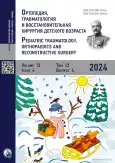长期牵伸腓肠三头肌计划对儿童高可动性平足及跟腱缩短患者腓肠三头肌纤维羽状角的影响
- 作者: Gorobets L.V.1,2, Kenis V.M.1,3
-
隶属关系:
- H. Turner National Medical Research Center for Сhildren’s Orthopedics and Trauma Surgery
- Medical Home
- North-Western State Medical University named after I.I. Mechnikov
- 期: 卷 12, 编号 4 (2024)
- 页面: 453-462
- 栏目: Clinical studies
- URL: https://journal-vniispk.ru/turner/article/view/282515
- DOI: https://doi.org/10.17816/PTORS642366
- ID: 282515
如何引用文章
详细
背景。腓肠三头肌的收缩在儿童平足的发病机制中具有重要意义。作为一组羽状肌,其肌纤维相对于腱膜的倾斜角度可以被测量,此角度称为羽状角或纤维羽状角。
研究目的。评估长期腓肠三头肌牵伸计划对高可动性平足伴跟腱缩短儿童腓肠三头肌纤维羽状角的影响。
材料与方法。研究包括82名患有高可动性平足及跟腱缩短的儿童。通过超声诊断测量腓肠三头肌纤维的羽状角。主要干预措施为持续6个月的腓肠三头肌牵伸训练。统计分析使用 SPSS v. 26.0 完成。
结果。实验组包括63名参与牵伸计划的儿童,对照组包括19名未按规定强度参与牵伸训练的儿童。 足部形态与位置评估量表(FPI-6):实验组显示显著改善,对照组无变化。足背屈角的变化: 初始值:实验组为4.84 ± 0.10°,对照组为4.81 ± 0.17°;6个月后:实验组为11.34 ± 0.24°, 对照组为4.85 ± 0.19°(p < 0.01)。纤维羽状角的变化:腓肠肌内侧头和比目鱼肌的纤维羽状角均显著增加。
结论。在平足儿童中实施长期牵伸计划可显著提高足背屈角。这些变化伴随着肌肉的形态和功能重塑,表现为腓肠肌内侧头和比目鱼肌纤维羽状角的显著增加。进一步研究将有助于揭示肌肉解剖和功能重塑的机制及其对平足解剖参数的影响。
作者简介
Leonid V. Gorobets
H. Turner National Medical Research Center for Сhildren’s Orthopedics and Trauma Surgery; Medical Home
Email: gorobetsleonid@gmail.com
ORCID iD: 0000-0001-9424-3713
MD, PhD Student
俄罗斯联邦, Saint Petersburg; Rostov-on-DonVladimir M. Kenis
H. Turner National Medical Research Center for Сhildren’s Orthopedics and Trauma Surgery; North-Western State Medical University named after I.I. Mechnikov
编辑信件的主要联系方式.
Email: kenis@mail.ru
ORCID iD: 0000-0002-7651-8485
SPIN 代码: 5597-8832
MD, PhD, Dr. Sci. (Medicine), Professor
俄罗斯联邦, Saint Petersburg; Saint Petersburg参考
- Harris RI, Beath T. Hypermobile flat-foot with short tendo achillis. J Bone Joint Surg Am. 1948;30A(1):116–140.
- Miskowiec RWI. The acute effects of stretching on pennation angle and force production [dissertation abstract]. 2012. 30 p. doi: 10.31390/gradschool_theses.2322
- Masenko VL, Kokov AN, Grigorieva II, et al. Radiology methods of the sarcopenia diagnosis. Research and Practical Medicine Journal. 2019;6(4):127–137. EDN: VIXNRI doi: 10.17709/2409-2231-2019-6-4-13
- Wu IT, Hyman SA, Norman MB, et al. Muscle architecture properties of the deep region of the supraspinatus: a cadaveric study. Orthop J Sports Med. 2024;12(10):23259671241275522. doi: 10.1177/23259671241275522.
- Zhang Y, Herbert RD, Bilston LE, et al. Three-dimensional architecture of the human subscapularis muscle in vivo. J Biomech. 2023;161:111854. doi: 10.1016/j.jbiomech.2023.111854
- Jiang W, Chen C, Xu Y. Muscle structure predictors of vertical jump performance in elite male volleyball players: a cross-sectional study based on ultrasonography. Front Physiol. 2024;15:1427748. doi: 10.3389/fphys.2024.1427748
- Wang R, Fu S, Huang R, et al. The diagnostic value of musculoskeletal ultrasound in the quantitative evaluation of skeletal muscle in chronic thyrotoxic myopathy: a single-center study in China. Int J Gen Med. 2024;17:3541–3554. doi: 10.2147/IJGM.S472442
- Fu H, Wang L, Zhang W, et al. Diagnostic test accuracy of ultrasound for sarcopenia diagnosis: A systematic review and meta-analysis. J Cachexia Sarcopenia Muscle. 2023;14(1):57–70. doi: 10.1002/jcsm.13149
- Moeskops S, Oliver JL, Radnor JM, et al. Effects of neuromuscular training on muscle architecture, isometric force production, and stretch-shortening cycle function in trained young female gymnasts. J Strength Cond Res. 2024;38(9):1640–1650. doi: 10.1519/JSC.0000000000004856
- Radnor JM, Oliver JL, Waugh CM, et al. Muscle architecture and maturation influence sprint and jump ability in young boys: a multistudy approach. J Strength Cond Res. 2022;36(10):2741–2751. doi: 10.1519/JSC.0000000000003941
- Dimitrieva AYu, Kenis VM. Medium-term results of body balance trainings in primary school-aged children with generalized joint hypermobility and symptomatic mobile flat foot: cohort study. Pediatric Pharmacology. 2021;18(5):347–358. EDN: YVHYML doi: 10.15690/pf.v18i5.2326
- Mosca VS. Principles and management of pediatric foot and ankle deformities and malformations. Philadelphia: Lippincott Williams & Wilkins; 2014.
- Dimitrieva AYu, Kenis VM, Klychkova IYu. Results of the first russian delphi survey on the diagnosis and treatment of flatfoot in children. Pediatric Traumatology, Orthopaedics and Reconstructive Surgery. 2023;11(1):49–66. EDN: CAHOCE doi: 10.17816/PTORS112465
- Wren TA, Cheatwood AP, Rethlefsen SA, et al. Achilles tendon length and medial gastrocnemius architecture in children with cerebral palsy and equinus gait. J Pediatr Orthop. 2010;30(5):479–484. doi: 10.1097/BPO.0b013e3181e00c80
- Moo EK, Leonard TR, Herzog W. The sarcomere force-length relationship in an intact muscle-tendon unit. J Exp Biol. 2020;223(Pt 6):jeb215020. doi: 10.1242/jeb.215020
- Nakamura M, Yoshida R, Sato S, et al. Comparison between high- and low-intensity static stretching training program on active and passive properties of plantar flexors. Front Physiol. 2021;12:796497. doi: 10.3389/fphys.2021.796497
- Mizuno T. Combined effects of static stretching and electrical stimulation on joint range of motion and muscle strength. J Strength Cond Res. 2019;33(10):2694–2703. doi: 10.1519/JSC.0000000000002260
- Panidi I, Bogdanis GC, Terzis G, et al. Muscle architectural and functional adaptations following 12-weeks of stretching in adolescent female athletes. Front Physiol. 2021;12:701338. doi: 10.3389/fphys.2021.701338
- Freitas SR, Mil-Homens P. Effect of 8-week high-intensity stretching training on biceps femoris architecture. J Strength Cond Res. 2015;29(6):1737–1740. doi: 10.1519/JSC.0000000000000800
- Dennis, Lacey G, The effects of static stretching on pennation angle and muscle power production in the triceps surae complex. Honors College Theses. 2017.
- Manal K, Roberts DP, Buchanan TS. Optimal pennation angle of the primary ankle plantar and dorsiflexors: variations with sex, contraction intensity, and limb. J Appl Biomech. 2006;22(4):255–263. doi: 10.1123/jab.22.4.255
补充文件








